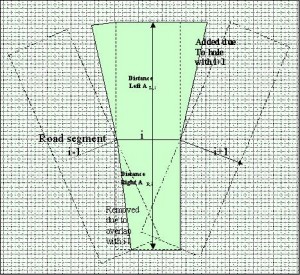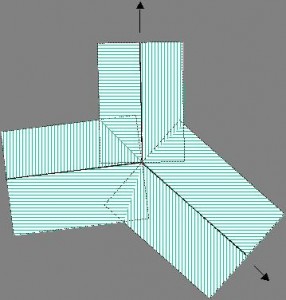Demis – Zoning Problem in Determining Environmental Impacts of Traffic #SWI2004
Introduction
Traffic has an impact on the environment. Traffic models are normally used to calculate the traffic intensities on the road network. The calculated traffic intensities form the basis for calculating environmental impacts. In the impact assessment, the traffic intensities are converted to the width of the zone that has negative impacts on the traffic. Examples of relevant environmental impacts are air and noise pollution. The impacted area can be considered as a buffer zone around the road network. To determine what the effects of the impact zone are, it is necessary to calculate the number of houses, inhabitants, the size of the nature area, and so forth.
The calculation has two steps:
- Determine the shape of the buffer zone as a polygon
- Determine the overlay area with other polygons
Step 1) Determining the shape of the buffer zone
Inputs:
- A collection of road segments with for each segment the following information:
- The position of the road segment is a collection of X,Y coordinates. By connecting the coordinates a poly-line is formed.
- The width of the buffer zone, both on the left and right side of the road segment (due to for example noise abatement constructions the width of the zone may be different on the left and the right-hand side)
Desired outputs:
- For each road segment, the buffer zone is a collection of X, Y coordinates. By connecting the points a (closed) polygon is formed.
- The buffer zone stretches from the road segment to the width specified as a buffer and is bordered by the buffer zones before and after the road segments
- Buffer zones are not allowed to overlap.
Possible approaches to solve the zoning problem:
- Use circles with a radius of the width of the buffer zone and follow the poly-line in small steps until the last point. Then construct the buffer zone, taking into account the rules given above.
- Use a parallel line at the specified distance and use the poly-line to construct the proper buffer zone. Al illustrative example is given in figure 1. In the figure, it is obvious that the parallel lines at distance AL,I and AR,i form the starting point. Due to the angles between the lines that make up the poly-line and the road segments, special solutions are needed to make up the proper buffer zone. In the figure on the right-hand side of the road, segment pieces need to be removed, while on the left-hand side area needs to be added. Special cases include road crossings and turn-offs.
Figure 1 Illustrative example of a buffer zone
The purpose of step 1) is to develop an algorithm that determines the buffer zone as a polygon.
An additional problem is how to eliminate the overlap in the buffer zones in sharp turns, where multiple buffer zones may overlap.
Step 2 Determining the overlay
Once the buffer zone has been determined, the next step is to calculate the overlapping area with other polygons such as natural areas. For the left-hand buffer and the right-hand buffer, a separate calculation is needed for the overlapping area.
In principle, the calculated buffer zone could be exported to the Geographic Information System (GIS) to calculate the overlay there. However due to the dynamic and interactive character of the traffic model a built-in overlay algorithm would be preferable.
Inputs:
- Polygon representing the buffer zone.
- Polygon representing the other area of interest
Desired outputs:
- A polygon with overlay area that lies in the buffer zone and the area of interest.
The purpose of step 2) is to develop an overlaying algorithm to determine the overlap between the buffer zone and the area of interest. The algorithm should be easy to implement in the traffic model.



